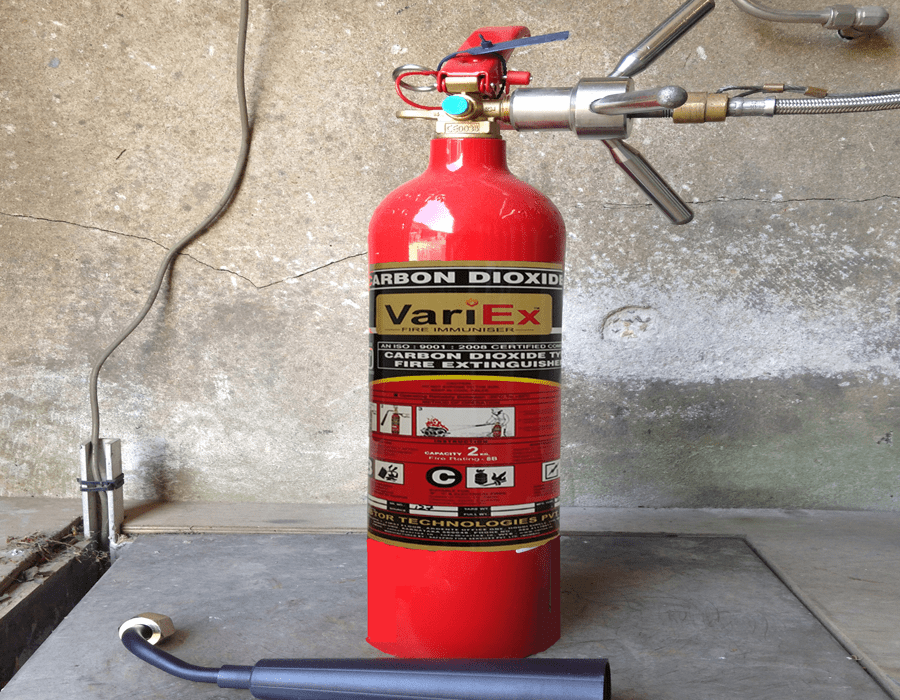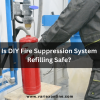![]()
Fire Immuniser
+91-7829629111
Email: info@variex.in
Varistor Technologies Pvt. Ltd.
Block-1, First Floor, Ardente Office One, Hoodi Circle, ITPL Main Road, Bengaluru, Karnataka 560048, IN
Fire Extinguisher Recharging | What You Need To Know
Fire extinguishers stand as crucial guardians in our battle against unexpected fires, providing a first line of defense in safeguarding lives and property. However, their effectiveness hinges on their readiness and functionality. In the course of time, fire extinguishers may lose pressure, expire, or face other issues that compromise their ability to combat flames effectively. This comprehensive guide delves into the essential aspects of fire extinguisher recharging, offering a detailed exploration of why, when, and how this critical maintenance process should be undertaken. From understanding the diverse types of fire extinguishers to recognizing the telltale signs that a recharge is needed, this guide equips readers with the knowledge necessary to ensure their firefighting equipment remains in optimal condition. Whether you're a homeowner, business owner, or safety professional, this guide aims to demystify the complexities of fire extinguisher recharging. It not only provides step-by-step instructions for those considering a DIY approach but also highlights the importance of seeking professional services when necessary. As we navigate the nuances of materials, tools, and legal standards, this resource aims to empower individuals and organizations to make informed decisions about maintaining their fire safety apparatus.
Materials and Tools Required for Recharging a Fire Extinguisher
Ensuring your fire extinguisher is in optimal working condition involves more than just visual inspections; it requires periodic recharging to maintain its effectiveness. Before embarking on the recharging process, it's essential to gather the right materials and tools. Here's a comprehensive list to guide you through this crucial maintenance task
Fire Extinguisher Recharge Kit: These kits typically include the necessary tools and materials, such as a pressure gauge, hose, recharge agent, and instructions. Ensure the kit matches the type of fire extinguisher you are recharging.
Safety Equipment:
Safety Glasses and Gloves: Protect your eyes and hands from potential contact with chemicals during the recharging process.
Protective Clothing: Wear appropriate clothing to safeguard yourself from any accidental spills or splashes.
Common Recharge Agents:
Dry Chemical Agents: ABC or BC dry chemical agents are commonly used for recharging. Ensure you have the specific agent recommended for your extinguisher.
Clean Agent: Halotron or CO2 is used in clean agent fire extinguishers. It leaves no residue, making it suitable for sensitive equipment.
Water and Foam Concentrates: Suitable for water and foam fire extinguishers, these concentrates restore the extinguishing capabilities of these units.
Pressure Gauge: A pressure gauge is essential for monitoring and verifying the pressure levels in the fire extinguisher. Make sure it is calibrated and functioning properly.
Hose and Nozzle: A flexible hose with a suitable nozzle is required to deliver the recharge agent into the extinguisher cylinder accurately.
Wrenches and Pliers: Use adjustable wrenches and pliers to safely remove and secure components during the disassembly and reassembly of the fire extinguisher.
Funnel: A funnel helps in pouring the recharge agent into the fire extinguisher without spillage.
Container for Waste Disposal: Have a container for collecting and disposing of any waste material or old recharge agent safely.
Ventilation Equipment: If working indoors, ensure proper ventilation to disperse any fumes emitted during the recharging process.
Manufacturer's Manual: Always consult the manufacturer's manual for your specific fire extinguisher model. It provides critical information on the correct recharge procedures and agent specifications.
Workbench or Stable Surface: Provide a stable and secure work surface for the disassembly and reassembly of the fire extinguisher.
Why Do Fire Extinguishers Require Recharging?
Fire extinguishers require recharging due to several factors that affect their ability to effectively combat fires. One primary reason is the discharge or partial discharge of the extinguishing agent during use, depleting the available resources. Additionally, over time, extinguishers may experience a loss of pressure, internal corrosion, and contamination, compromising their integrity. The expiration of extinguishing agents and compliance with regulatory maintenance requirements also necessitate recharging. Post-use assessments after a fire incident further highlight the importance of thorough inspections and repairs to ensure the extinguisher's reliability in emergency situations. Regular recharging is essential to maintain the extinguisher's operational capacity, uphold safety standards, and comply with regulatory guidelines.
When Do You Need a Fire Extinguishers Refill?
A fire extinguisher requires a refill under various circumstances to ensure its continued efficacy in fire emergencies. Primarily, if the extinguisher has been used, even partially, it needs immediate attention. Any discharge depletes the extinguishing agent, rendering it less effective for future use. Regular inspections are also crucial, and if the pressure gauge indicates a loss of pressure or if there are visible signs of damage, a refill is necessary. Expiration dates on extinguishers are another key factor; once an extinguisher reaches its expiration, it should be promptly refilled or replaced. Additionally, adherence to manufacturer-recommended maintenance schedules and compliance with local regulations and safety standards are essential considerations for determining when a fire extinguisher needs a refill. Ultimately, proactive and timely refilling ensures the extinguisher remains a reliable and functional tool for fire prevention and safety.
Do All Fire Extinguishers Need To Be Refilled?
Not all fire extinguishers need to be refilled on a regular basis; however, their maintenance requirements vary based on factors such as the type of extinguisher, usage history, and manufacturer guidelines. Disposable or single-use fire extinguishers are typically discarded after use and replaced with a new unit. Rechargeable extinguishers, on the other hand, necessitate refilling after any use, even if only partially discharged. Regular inspections are essential to determine if there are signs of damage, loss of pressure, or if the extinguisher has reached its expiration date. Adhering to these maintenance checks and manufacturer recommendations ensures that fire extinguishers are ready for use in case of an emergency and helps to uphold safety standards and regulatory compliance.
What is the Fire Extinguisher Recharging Process?
The fire extinguisher recharging process is a meticulous and systematic procedure aimed at restoring the extinguisher to its optimal operational state. It typically begins with a visual inspection to assess the overall condition of the extinguisher, checking for any signs of damage or corrosion. The extinguisher is then discharged to ensure it is depressurized. After disassembly, components such as the valve, hose, and nozzle are carefully examined for wear, tear, or blockages. The next step involves refilling the extinguisher with the appropriate extinguishing agent as specified by the manufacturer, ensuring accurate quantities and adherence to safety guidelines. Reassembly follows, and the extinguisher undergoes a pressure test to verify that it can maintain the necessary pressure for effective use. Finally, the exterior is cleaned, and a new inspection tag is often affixed to indicate the recharging date and the technician's certification. This thorough process ensures that the fire extinguisher is fully operational, compliant with safety standards, and ready for deployment in the event of a fire emergency.
In conclusion, understanding the intricacies of fire extinguisher recharging is paramount for maintaining a robust line of defense against potential fire emergencies. Regular inspections, adherence to manufacturer guidelines, and timely recharging are critical components of ensuring that these life-saving devices stand ready and reliable when needed most. Whether considering a do-it-yourself approach or relying on certified professionals, the commitment to this essential maintenance task contributes directly to the safety of individuals and the protection of property. The insights gained from comprehending the types of extinguishers, recognizing signs for recharging, and navigating the process itself empower individuals and organizations to be proactive stewards of fire safety. As we conclude this exploration, let the knowledge gleaned serve as a catalyst for a culture of vigilance, where fire extinguishers are not merely devices on the wall but active guardians prepared to combat the unexpected and secure our well-being.
Frequently asked questions
1. How often should a fire extinguisher be recharged?
Fire extinguishers should be recharged after any use, regardless of the amount discharged. Regular visual inspections and adherence to manufacturer guidelines help determine the need for recharging, but a professional inspection is advisable annually.
2. Can I recharge a fire extinguisher myself?
While recharge kits are available, it's recommended to have a certified professional handle the process. They ensure the correct extinguishing agent is used, conduct a thorough inspection, and guarantee compliance with safety standards.
3. What happens if I don't recharge a fire extinguisher?
Neglecting to recharge a fire extinguisher can lead to its ineffectiveness in combating fires. It may result in reduced pressure, expired extinguishing agents, or unnoticed damage, compromising the extinguisher's reliability and potentially putting lives and property at risk.
4. How do I know if my fire extinguisher needs recharging?
Signs include a low pressure gauge reading, visible damage, or if the extinguisher has been used. Regular visual inspections, checking the expiration date, and professional assessments contribute to identifying the need for recharging.
5. Can I recharge an expired fire extinguisher?
It's not advisable to recharge an expired extinguisher. Expired units should be replaced with a new one, as the extinguishing agents may have degraded over time, impacting their effectiveness.
6. What are the costs associated with fire extinguisher recharging?
Costs vary based on factors such as the type of extinguisher, the extent of the recharge, and local service rates. It's recommended to obtain quotes from certified professionals and consider it an investment in safety.
Final Say
We at VariEx.in or Variexonline.com have mastered the art of designing, installing, inspecting, and fixing automatic sprinkler systems with the help of our in-house team, which is capable of delivering the fire sprinkler services you need, whether large or small and at affordable cost.
To schedule a fire sprinkler installation, or you think our services could benefit your commercial property, contact us online or give us a call at, 7829629111










